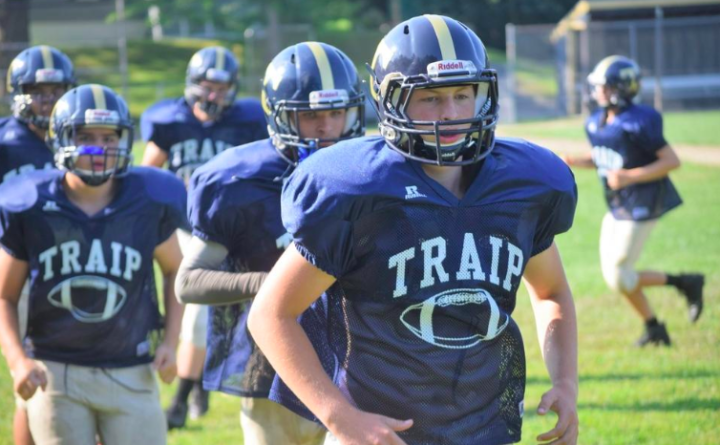More Maine high schools will be competing in a new eight-player football class this fall than will be playing in the largest-school division of the 11-player version of the sport.
Those were among the recommendations given final approval by the full membership of the Maine Principals’ Association during its spring interscholastic business meeting held Thursday morning at the Samoset Resort in Rockport.
The MPA membership also voted to keep the enrollment cutoff for Class C and Class D basketball at 129 students for the next two years.
In football, the Class A 11-player ranks will decrease from 14 schools last fall to eight while 10 schools will field eight-player football squads for the first time later this year.
The new eight-player class, the result of declining enrollments and football participation numbers, will have five programs in a large-school division of 351-plus students and five others in a small-school division of 350 or fewer students.
[10 Maine schools approved for 8-player football this fall]
Schools to debut in the eight-player large-school division this fall are Mt. Ararat of Topsham (709 students), Gray-New Gloucester (596), Yarmouth (509), Ellsworth (455) and Maranacook of Readfield (361).
Sacopee Valley of South Hiram (310), Traip Academy of Kittery (255), Old Orchard Beach (243), Boothbay (199) and Telstar of Bethel (199) will compete in the eight-player small-school division.
For Ellsworth, which has played 11-player football in Class D but would have been moved up to Class C by enrollment this fall, the change to eight-player football represents a chance to survive and rebuild a program that anticipated having just 10 returning players this fall.
“When we started this program we went 27 games without a win, and I did not want to go back there,” Ellsworth coach Duane Crawford said. “When we looked at what we had for returning players, the freshmen that have signed up that may or may not come in and a couple of upperclassmen that may or may or may not play, we were looking at having 20 players again this year.
“You can’t play 11-man football with 20 players. It was the logical choice to take.”
That reduction in the number of Class A schools resulted largely from competitive concerns stemming from enrollment differentials between the largest and smallest schools in the division.
[Bangor poised for change to Class A football alignment]
Thornton Academy of Saco, which has been the largest school in the state for three of the last four classification cycles, has won four of the past seven Class A football state championships. Its enrollment exceeds that of South Portland, the smallest Class A school that did not petition to play in the large-school division for the most recent two-year cycle, by more than 500 students.
The MPA’s football and classification committees voted unanimously on April 8 to recommend to the full membership a plan that would leave just the eight largest football-playing schools in a statewide Class A division for the next two years. This decision still allows six other programs to compete in Class B.
“A number of people in football spoke that having just eight schools in Class A was too few and others felt that they just couldn’t compete with the numbers in their programs and that it probably wasn’t safe,” MPA assistant executive director Mike Burnham said.
Class A now will consist of eight schools with 950-plus students: Thornton Academy (1,476), Lewiston (1,420), Bangor (1,202), Bonny Eagle of Standish (1,094), Oxford Hills of South Paris (1,021), Edward Little of Auburn (998), Sanford (982) and Scarborough (973).
Former Class A teams that will compete in Class B (800-949 students) this fall are Windham (941), Deering of Portland (929), Massabesic of Waterboro (927), South Portland (898), Portland (757) and Cheverus of Portland (394).
Cheverus traditionally had petitioned to play Class A football but instead has petitioned to play up in Class B for the next two years.
[Subscribe to our free morning newsletter and get the latest headlines in your inbox]
In basketball, the MPA membership voted to keep the enrollment cutoff for Class C and Class D basketball at 129 students for the next two years.
Two proposals had been under consideration, one retaining the same 129-student cutoff number between those classes, as had been the case for the last two years, and the second upping that cutoff to 139. The higher number was proposed after five schools with enrollments between 129 and 139 — Central Aroostook of Mars Hill, Fort Fairfield, Hodgdon, Richmond and Woodland — had appealed their placements in Class C for the next two years to the MPA’s interscholastic management committee.
When the MPA’s basketball and classification committees opted not to change their earlier recommendation of 129, both numbers were sent forward for full MPA consideration.
This was the latest example of the challenge MPA committees face in addressing “enrollment differential,” or the difference in enrollment between the largest and smallest schools in a class.
The five schools that appealed their classifications now will be the smallest in Class C for the next two years, with Central Aroostook, Fort Fairfield, Hodgdon and Woodland in the North and Richmond in the South.
Woodland is the only one of the five that will be moved up from Class D to Class C as a result of the vote.
“There was significant conversation in support of both sides of that argument,” Burnham said. “It was one of those issues where you did see both sides but one of those sides was not going to get what they were hoping for.”
Both the MPA basketball and classification committees have committed to working during the next two-year cycle to address the issue and consider other alternatives, Burnham said.
This article originally appeared on www.bangordailynews.com.





